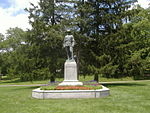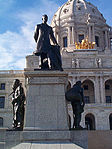art.wikisort.org - Artist
Andrew O'Connor (June 7, 1874 – June 9, 1941) was an American-Irish sculptor whose work is represented in museums in America, Ireland, Britain and France.[1]

Life
O'Connor was born in Worcester, Massachusetts and died in Dublin, Ireland. For a time he was in the London studio of the painter, John Singer Sargent, and later worked for the architects, McKim, Mead and White in America and with the sculptor Daniel Chester French. Settling in Paris in the early years of the 20th century, he exhibited annually at the Paris Salon. In 1906 he was the first foreign sculptor to win the Second Class medal for his statue of General Henry Ware Lawton, now in Garfield Park in Indianapolis. In 1928 he achieved a similar distinction by being awarded the Gold Medal for his Tristan and Iseult, a marble group now in the Brooklyn Museum. His work was also part of the sculpture event in the art competition at the 1928 Summer Olympics.[2]
A number of his plaster casts are in the Hugh Lane Municipal Gallery, Dublin and there are works in Tate Britain,[3] the Walters Art Museum, Baltimore, the Corcoran Gallery of Art, the Metropolitan Museum of Art and the Musée d'Art Moderne, Paris.
O'Connor was involved in a minor controversy in 1909 when he was commissioned to design a statue for Commodore John Barry, of the American Revolutionary-era navy. O'Connor's first design was heatedly attacked by Irish-American groups. He submitted a second version, but it too was ultimately rejected, and the sculptor John J. Boyle received the commission.[4]
Selected works
- Vanderbilt Memorial Doors, St Bartholomew's Church, Manhattan, New York City, 1901–03
- General Henry Ware Lawton, Garfield Park, Indianapolis, Indiana, 1906
- Statue of Lew Wallace, National Statuary Hall Collection, U.S. Capitol, Washington, D.C., 1910
- Governor John Albert Johnson, Minnesota State Capitol, St. Paul, 1912[5]
- 1898 Soldier, Spanish–American War Memorial, Wheaton Square, Worcester, Massachusetts, 1917. The model for O'Connor's statue was his student, Vincent Schofield Wickham.[6]
- Abraham Lincoln, Illinois State Capitol, Springfield, 1918
- The Victims, Merrion Square, Dublin, Ireland, c. 1923, (dedicated 1947). Intended for a World War I Memorial in Washington, D.C. (abandoned), it depicts a kneeling wife and a standing mother mourning a dead soldier.[7]
- A copy of Kneeling Wife (c. 1923) is at the Tate Britain.[3]
- Lafayette Monument, Mount Vernon Place, Baltimore, Maryland, 1924
- Christ the King, Dún Laoghaire, Ireland, 1926
- Tristan and Iseult, Brooklyn Museum, Brooklyn, New York City, 1928[8]
- Bust of Abraham Lincoln, Royal Exchange, London, United Kingdom, 1930
- Seated Abraham Lincoln, Fort Lincoln Cemetery, Brentwood, Maryland, 1931 (dedicated 1947). The statue was commissioned for the Rhode Island Statehouse, but the project was abandoned during the Depression.[9]
- Vanderbilt Doors (1903), St. Bartholomew's Church, New York City
- Gen. Henry Ware Lawton (1906), Indianapolis, Indiana
- Gen. Lew Wallace (1910), U.S. Capitol, Washington, D.C.
- Gov. John Albert Johnson (1912), St. Paul, Minnesota
- 1898 Soldier (1917), Worcester, Massachusetts
- Abraham Lincoln (1918), Springfield, Illinois
 The Victims (c. 1923), Dublin, Ireland
The Victims (c. 1923), Dublin, Ireland- Equestrian statue of the Marquis de LaFayette (1924), Baltimore, Maryland
- Christ the King (1926), Dún Laoghaire, Ireland
- Seated Abraham Lincoln (1931), Brentwood, Maryland
References
- Homan Potterton, Andrew O'Connor 1874–1941, Catalogue of an Exhibition at Trinity College, Dublin, 1974; Doris Flodin Soderman, The Sculptors O'Connor: Andrew Sr, 1847–1924, Andrew Jr, 1874–1941 (Worcester, Mass, 1995).
- "Andrew O'Connor". Olympedia. Retrieved 29 July 2020.
- "Andrew O'Connor – Tate". Tate. Retrieved 4 August 2015.
- Flanagan, Neil (16 April 2014). "How Politics Sank a Radical Monument 105 Years Ago". Greater Greater Washington. Retrieved 20 February 2020.
{{cite web}}: CS1 maint: url-status (link) - "Start Seeing Art". startseeingart.com. Archived from the original on 24 September 2015. Retrieved 4 August 2015.
- Soderman, Doris Flodin (1995). The Sculptors O'Connor. Worcester, MA: Gundi Press. p. 69. ISBN 0-9642863-0-0.
- Art in Parks: A Guide to Sculpture in Dublin City Council Parks, (Dublin, 2014).
- Tristan and Iseult, from Brooklyn Museum.
- "The Statue at Fort Lincoln Cemetery," Lincoln Lore, no. 946 (May 26, 1947), Lincoln National Life Insurance Company, Fort Wayne, Indiana.
| Wikimedia Commons has media related to Andrew O'Connor, Jr.. |
Другой контент может иметь иную лицензию. Перед использованием материалов сайта WikiSort.org внимательно изучите правила лицензирования конкретных элементов наполнения сайта.
WikiSort.org - проект по пересортировке и дополнению контента Википедии









